
Algebra Xpresser was used to explore, understand and extend the
following function..
The parameters a, b, and c of the above equation are first described in terms of the cyclical sine function graphed below. Then, the function is related to something commonly familiar in everyday life. The parameters a, b, and c are varied and the results graphed. These graphs along with discussion of their results, is presented below.
First, lets see the graph of this equation with a and b equal to 1,
and c equal to 0. This is the basic sinusoidal function of trigonometry.
Next Page

We can give names to the various sinusoidal properties of the sine wave. The maximum to minimum value of the graph on the y axis is known as the amplitude of the wave. The location that the graph crosses the x axis from a negative y value to a positive y value determines the phase of the wave. The one we see above has phase equal to 0 because the graph passes through the origin as it goes from negative to positive. Finally, the distance from one positive peak of the wave to the next determines the frequency of the wave. This frequency is often measured in the number of cycles the wave completes in a unit of measurement along the x axis. A cycle occurs when the wave has passed through every possible y value it can have exactly once. These properties of the sine wave determine to a great extent how it is used.
Many things in everyday life are represented by a sine wave. Electricity found in the home is one thing that can be so represented. It has a sine wave output, an amplitude of around 120 in units called volts. The current from the wall outlet is called single phase and characteristically its phase is said to be 0. The sine wave operates at frequency of 60 cycles per second. Now, letís see what happens as we change the a , b, and c parameters. First we change the a parameterNext Page

Next, we vary the b parameter.
Next Page

Now, we vary the c parameter.Next Page
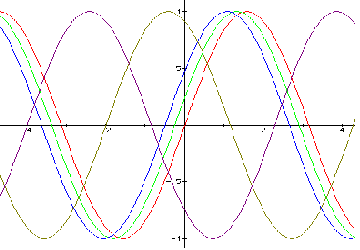
Now that we've seen the affects the basic parameters have on the
wave, let's explore some combinations of these. In particular, lets look
at something called the harmonics. The harmonics of a particular sine
wave at a certain frequency are sine waves whose frequencies vary from
that of the particular sine wave by whole multiples and whose amplitudes
are less. We know from above that if sin x represents the particular
sine wave, we can change the frequency by whole multiples with the b
parameter and we can make the amplitude less by reducing a. We end the
discussion with a look at what happens when we combine sine waves and
their even and odd harmonics. Next Page
This is a graph of even harmonics. The basic sine wave is graphed in red as y = sin x. As these are even harmonics, the green line is the equation y = 1/2 sin 2x. Also, the blue is y = 1/4 sin 4x, the olive is y = 1/6 sin 6x, and finally, the purple is y = 1/8 sin 8x.Next Page
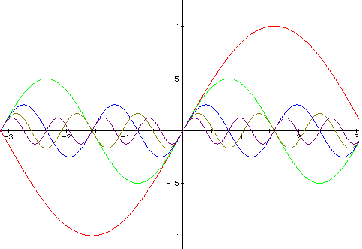
When we add the even harmonics together, this is what we get. As you can see, it is a somewhat distorted sine wave. Next Page
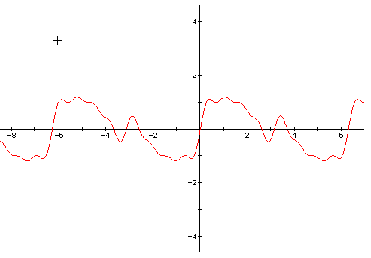
The following graph places a sine wave (red) and some of it's odd harmonics on the same graph. Red is the graph of y = sin x, the basic sine wave. The green line graphs y = 1/3 sin 3x, blue y = 1/5 sin 5x, olive y = 1/7 sin 7x; and finally purple graphs y = 1/9 sin 9x.Next Page
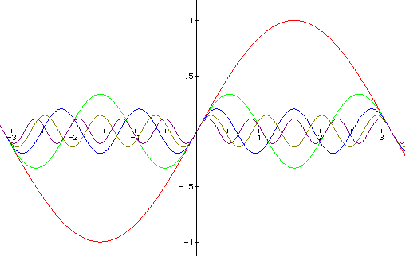
When we add these odd functions together, we get the following result. This is very close to something called a square wave. This is what the signals a computer sends to a modem look like.Next Page
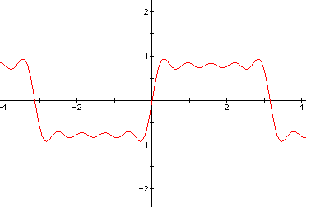
There are many more ways one can combine the various sine wave functions. The Algebra Xpresser is an excellent tool to facilitate these explorations. Using it, we have been able to visually relate the sine function to something we run across in our every day experiences. These concepts apply not only to electricity, but to most sinusoidal vibrating things . . . from springs on a car to strings on a guitar. I believe this visualization is a most helpful tool in appreciating these concepts and that this little foray into the sine wave has been worth while. "Return to Home Page".
THE END